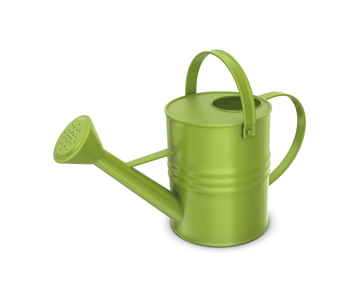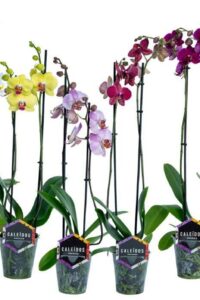Hazeu Orchids is a nursery that has been run by the Hazeu family for four generations and is located in Pijnacker. The first generation started with growing vegetables, but today Chiel and Sjors Hazeu have fully specialised in growing Phalaenopsis in a 12 cm cultivation pot. Production takes place under 68,000 m2 of glass. They distinguish themselves by growing in a hexagonal cultivation pot, i.e. the nursery pot has 6 corners. This shape of this pot increases the efficiency of the whole chain. For instance, it results in a transport advantage of 20%, and a 20% energy reduction and 16.4% lower CO2 emissions compared to the ‘normal’ circular cultivation pot. This innovation has already won Hazeu Orchids several awards. The company focuses on the retail segment and sells most of its production under the name ‘Caleidos’. The literal translation of this is “polygonal”. More information can be found at www.hazeuorchids.nl.
Hazeu Orchids

Sustainability
Hazeu Orchids has not become more sustainable overnight. This has been a process of years. Partly due to questions from customers and consumers, the company slowly gradually became aware of the increasing importance to look closely at operations and, in particular, at sustainability.
Water
All rainwater falling on the roof of the greenhouse and commercial buildings , is collected in a water basin. This water is used to water the plants by means of a spraying system. This is fully computer controlled. This way, the plants can be watered as needed. The water is also supplied with the optimum amount of nutrients, so there is little waste. The water that is not absorbed by the plants , is collected in a water silo. After disinfection the water is then reused. They therefore do not use tap water.
No“dirty” ends up in the surface water. The water consumption in the nursery has no influence on the drinking water supplies in the region.
Biodiversity
To produce the plants, the company mainly uses a lot of organic plant protection products. Only if there is no other way, they will use some non-natural pesticides. Over the past 5 years, the use of organic resources has increased significantly and the use of non-natural resources has decreased dramatically. They have invested a lot of time in research into ways to deal with diseases and pests in a organic way. Unfortunately, at the moment, it is not yet possible to work completely organically.
Climate
In their current form the greenhouses are equipped with the most modern techniques in view of the future and the environment. For example, Hazeu Orchids has energy-efficient screen cloths, a heat pump and multiple combined heat and power (CHP) units. The CHP allows the company to generate its own electricity, releasing heat and CO2. All released energy and CO2 is used in the greenhouse to make the plants grow as well as possible.
6000 solar panels installed on the roof of the barn allow to obtain additional energy.
The environment is also taken into account in terms of transport. There is an electric company car. Customers also collect many goods directly from the nursery or products are taken directly to retailers’ depots. This minimises the number of transport movements.
Changing the shape of the cultivation pots and all the investments described above are aimed at reducing the use of fossil fuels.
Hazeu Orchids is in possession of the environmental certificates MPS-A, MPS-GAP and MPS SQ.
– MPS-A – indicates the level of sustainability of the company’s operations.
– MPS-GAP – for companies that supply to retailers and concerns traceability, environment, safety and hygiene. MPS-GAP is the next step beyond MPS-A on the road to sustainability.
– MPS SQ – relates to the social aspects of business operations
In addition, Hazeu Orchids is a member of the Horti Footprint Chain Program. Participants in the Horti Footprint Chain Program want to produce in a climate-neutral way. The aim is for each party in the horticultural sector to gain insight into its share of the final product’s CO2 footprint, in order to subsequently reduce its emissions.
The diagrams below show graphs of Hazeu Orchids’ consumption of crop protection agents, energy and fertilisers. The black stripes are the set standards. The limits indicated are the legal limits for environmental pollution. The limits indicated are the permissible legal limits for environmental impact.




People
Hazeu Orchids employs 100 staff across all its locations. Of these, 15 are permanent employees and 85 are hired through a certified temporary employment agency.
Many retail chains do not only pay attention to the environment, but increasingly focus on the social aspects of business operations. That is why Hazeu Orchids has also obtained the required certificates (MPS-SQs) in the field of employee relations.
The guidelines of the Collective Labour Agreement for greenhouse horticulture are well observed. Employees have an employment contract, establishing matters such as the number of days of leave, salary and working hours etc. Permanent employees and temporary employees have the same rights; employees are paid in accordance with the applicable Collective Labour Agreement standards. This also guarantees income security that should enable employees to provide themselves with decent housing.
Within the company, men and women have equal development opportunities and the possibility to be able to develop themselves further and thus grow into another position.
They also provide good protective work clothing and a safe working environment. In addition, each employee gets the freedom to express his/her own religion.
In the region, Hazeu sponsors on a regular basis and participates annually in the Tour for Life for cancer research.

Health

Care
Phalaenopsis:










